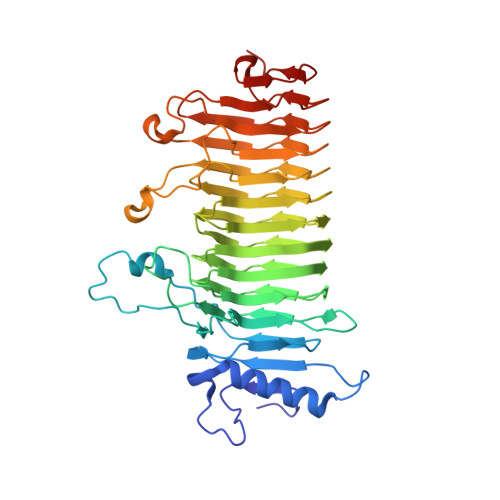Elucidation of the mechanism underlying the sequential catalysis of inulin by fructotransferase.
Chen, G., Wang, Z.X., Yang, Y., Li, Y., Zhang, T., Ouyang, S., Zhang, L., Chen, Y., Ruan, X., Miao, M.(2024) Int J Biol Macromol 277: 134446-134446
- PubMed: 39098696
- DOI: https://doi.org/10.1016/j.ijbiomac.2024.134446
- Primary Citation of Related Structures:
9J4I, 9J4J, 9J4K, 9J4L - PubMed Abstract:
Glycoside hydrolase family 91 (GH91) inulin fructotransferase (IFTases) enables biotransformation of fructans into sugar substitutes for dietary intervention in metabolic syndrome. However, the catalytic mechanism underlying the sequential biodegradation of inulin remains unelusive during the biotranformation of fructans. Herein we present the crystal structures of IFTase from Arthrobacter aurescens SK 8.001 in apo form and in complexes with kestose, nystose, or fructosyl nystose, respectively. Two kinds of conserved noncatalytic binding regions are first identified for IFTase-inulin interactions. The conserved interactions of substrates were revealed in the catalytic center that only contained a catalytic residue E205. A switching scaffold was comprised of D194 and Q217 in the catalytic channel, which served as the catalytic transition stabilizer through side chain displacement in the cycling of substrate sliding in/out the catalytic pocket. Such features in GH91 contribute to the catalytic model for consecutive cutting of substrate chain as well as product release in IFTase, and thus might be extended to other exo-active enzymes with an enclosed bottom of catalytic pocket. The study expands the current general catalytic principle in enzyme-substrate complexes and shed light on the rational design of IFTase for fructan biotransformation.
- State Key Laboratory of Food Science and Technology, Jiangnan University, Wuxi 214122, China; College of Food and Health, Zhejiang Agriculture and Forest University, Hangzhou 311300, China.
Organizational Affiliation:
















